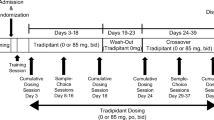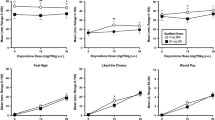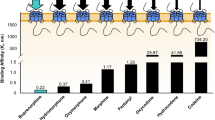Abstract
Aims
Intravenous (IV) misuse of the µ opioid analgesic oxymorphone has caused significant public health harms; however, no controlled data on its IV abuse potential are available. The primary aims of this pilot study were to directly compare IV oxymorphone to IV oxycodone, morphine, and hydromorphone on a subjective measure of drug liking and to assess relative potency.
Methods
Participants (n = 6) with opioid use disorder, physical dependence, and current IV use completed this two-site, within-subject, double-blind, placebo-controlled, inpatient pilot study. During each session, one IV dose (mg/70 kg) was administered: oxymorphone (1.8, 3.2, 5.6, 10, 18, 32), hydromorphone (1.8, 3.2, 5.6, 10, 18), oxycodone (18, 32, 56), morphine (18, 32), and placebo. Data were collected before and for 6 h after dosing. Primary outcomes included safety/physiological effects, subjective reports of drug liking, and relative potency estimates.
Results
All active test drugs produced prototypical, dose-related µ opioid agonist effects (e.g., miosis). Oxymorphone was more potent than the comparator opioids on several measures, including drug liking and respiratory depression (p < 0.05). Across abuse-related subjective outcomes, oxymorphone was 2.3–2.8-fold more potent than hydromorphone and 12.5–14-fold more potent than oxycodone (p < 0.05).
Conclusions
Despite the relatively small sample size, this pilot study detected robust oxymorphone effects. Oxymorphone was far more potent than the comparator opioids, particularly on abuse potential outcomes. Overall, these findings may help explain surveillance reports that demonstrate, after adjusting for prescription availability, oxymorphone is injected at the highest frequency, relative to other prescription opioids.



Similar content being viewed by others
References
Ambruzs JM, Serrell PB, Rahim N, Larsen CP (2014) Thrombotic microangiopathy and acute kidney injury associated with intravenous abuse of an oral extended-release formulation of oxymorphone hydrochloride: kidney biopsy findings and report of 3 cases. Am J Kidney Dis 63:1022–1026
Appleton JC (1960) Clinical evaluation and observation of 14-hydroxydihydromorphinone (Numorphan). Anesth Analg 39:505–510
Aqua K, Gimbel JS, Singla N, Ma T, Ahdieh H, Kerwin R (2007) Efficacy and tolerability of oxymorphone immediate release for acute postoperative pain after abdominal surgery: a randomized, double-blind, active- and placebo-controlled, parallel-group trial. Clin Ther 29:1000–1012
Babalonis S, Lofwall MR, Nuzzo PA, Walsh SL (2016) Pharmacodynamic effects of oral oxymorphone: abuse liability, analgesic profile and direct physiologic effects in humans. Addict Biol 21:146–158
Ballinger GA (2004) Using generalized estimating equations for longitudinal data analysis. Organ Res Methods 7:127–150
Ban BH, Verma A, Tudor M, Sethi J (2017) Opana-induced thrombotic microangiopathy masquerading as thrombotic thrombocytopenic purpura. Oxf Med Case Reports 2017:omx026
Beaver WT, Feise GA (1977) A comparison of the analgesic effect of oxymorphone by rectal suppository and intramuscular injection in patients with postoperative pain. J Clin Pharmacol 17:276–291
Beaver WT, Wallenstein SL, Houde RW, Rogers A (1977) Comparisons of the analgesic effects of oral and intramuscular oxymorphone and of intramuscular oxymorphone and morphine in patients with cancer. J Clin Pharmacol 17:186–198
Coblentz A, Bierman HR (1956) The analgesic properties of numorphan (14-hydroxy dihydromorphinone), a new synthetic narcotic. N Engl J Med 255:694–698
Bonnecaze AK, Wilson MW, Dharod A, Fletcher A, Miller PJ (2018) Acute kidney injury is common with intravenous abuse of extended-release oral oxymorphone and delayed renal recovery rates are associated with increased KDIGO staging. Nephrology (carlton) 23:921–926
Broz D, Zibbell J, Foote C, Roseberry JC, Patel MR, Conrad C, Chapman E, Peters PJ, Needle R, McAlister C, Duwve JM (2018) Multiple injections per injection episode: High-risk injection practice among people who injected pills during the 2015 HIV outbreak in Indiana. Int J Drug Policy 52:97–101
Butler SF, Cassidy TA, Chilcoat H, Black RA, Landau C, Budman SH, Coplan PM (2013) Abuse rates and routes of administration of reformulated extended-release oxycodone: initial findings from a sentinel surveillance sample of individuals assessed for substance abuse treatment. J Pain 14:351–358
Carliss RD, Keefer JF, Perschke S, Welch S, Rich TC, Weissman AD (2009) Receptor reserve reflects differential intrinsic efficacy associated with opioid diastereomers. Pharmacol Biochem Behav 92:495–502
Cassidy TA, DasMahapatra P, Black RA, Wieman MS, Butler SF (2014) Changes in prevalence of prescription opioid abuse after introduction of an abuse-deterrent opioid formulation. Pain Med 15:440–451
Cicero TJ, Ellis MS, Kasper ZA (2016) A tale of 2 ADFs: differences in the effectiveness of abuse-deterrent formulations of oxymorphone and oxycodone extended-release drugs. Pain 157:1232–1238
Ciliberti BJ, Eddy NB (1961) Pre-anaesthetic medication: morphine, anileridine, oxymorphone and placebo. Bull Narc 3:1–8
Comer SD, Sullivan MA, Whittington RA, Vosburg SK, Kowalczyk WJ (2008) Abuse liability of prescription opioids compared to heroin in morphine-maintained heroin abusers. Neuropsychopharmacology 33:1179–1191
Crum ED, Bailey KM, Richards-Waugh LL, Clay DJ, Gebhardt MA, Kraner JC (2013) Validation of blood and liver oxymorphone analysis using LC-MS-MS: concentrations in 30 fatal overdoses. J Anal Toxicol 37:512–516
Dasgupta N, Freifeld C, Brownstein JS, Menone CM, Surratt HL, Poppish L, Green JL, Lavonas EJ, Dart RC (2013) Crowdsourcing black market prices for prescription opioids. J Med Internet Res 15:e178
Diggle PJ, Liang K, Zeger SL (1996) Analysis of Longitudinal Data. Oxford University Press, Inc
Eddy NB, Lee LE Jr (1959) The analgesic equivalence to morphine and relative side action liability of oxymorphone (14-hydroxydihydro morphinone). J Pharmacol Exp Ther 125:116–121
Endo Pharmaceuticals (2006). Prescribing Information and Package Insert, Opana® (oxymorphone hydrochloride) injection (1 mg/mL ampules). Chadds Ford, PA
Endo Pharmaceuticals (2016). Prescribing Information and Package Insert, Opana ER® (oxymorphone hydrochloride) extended-release tablets (5 mg, 7.5 mg, 10 mg, 15 mg, 20 mg, 30 mg, 40 mg). Malvern
Finney DJ (1964) Statistical method in biological assay, 2nd edn. New York, Hafner
Fraser HF, Nash TL, Vanhorn GD, Isbell H (1954) Use of miotic effect in evaluating analgesic drugs in men. Arch Int Pharmacodyn Ther 98:443–451
Fraser HF, Isbell H (1955) Addictive properties of morphine derivatives. Published abstracts from the American Society for Pharmacology and Experimental Therapeutics. Charlottesville, VA, Sept. 6–8, 1954
Fraser HF, Van Horn GD, Martin WR, Wolbach AB, Isbell H (1961) Methods for evaluating addiction liability. (A) “Attitude” of opiate addicts toward opiate-like drugs. (B) a short-term “direct” addiction test. J Pharmacol Exp Ther 133:371–387
Gabrail NY, Dvergsten C, Ahdieh H (2004) Establishing the dosage equivalency of oxymorphone extended release and oxycodone controlled release in patients with cancer pain: a randomized controlled study. Curr Med Res Opin 20:911–918
Garside D, Hargrove RL, Winecker RE (2009) Concentration of oxymorphone in postmortem fluids and tissue. J Anal Toxicol 33:121–128
Gibbons RD, Hedeker D, Elkin I, Waternaux C, Kraemer HC, Greenhouse JB, Shea MT, Imber SD, Sotsky SM, Watkins JT (1993) Some conceptual and statistical issues in analysis of longitudinal psychiatric data. Application to the NIMH treatment of Depression Collaborative Research Program dataset. Arch Gen Psychiatry 50:739–750
Gimbel J, Ahdieh H (2004) The efficacy and safety of oral immediate-release oxymorphone for postsurgical pain. Anesth Analg 99:1472–7
Gimbel JS, Walker D, Ma T, Ahdieh H (2005) Efficacy and safety of oxymorphone Immediate release for the treatment of mild to moderate pain after ambulatory orthopedic surgery: results of a randomized, double-blind, placebo-controlled trial. Arch Phys Med Rehabil 86:2284–2289
Girardin F, Rentsch KM, Schwab MA, Maggiorini M, Pauli-Magnus C, Kullak-Ublick GA, Meier PJ, Fattinger K (2003) Pharmacokinetics of high doses of intramuscular and oral heroin in narcotic addicts. Clin Pharmacol Ther 74:341–352
Hale ME, Ahdieh H, Ma T, Rauck R, Oxymorphone ERSG (2007) Efficacy and safety of OPANA ER (oxymorphone extended release) for relief of moderate to severe chronic low back pain in opioid-experienced patients: a 12-week, randomized, double-blind, placebo-controlled study. J Pain 8:175–184
Hale ME, Dvergsten C, Gimbel J (2005) Efficacy and safety of oxymorphone extended release in chronic low back pain: results of a randomized, double-blind, placebo- and active-controlled phase III study. J Pain 6:21–28
Hunt R, Yalamanoglu A, Tumlin J, Schiller T, Baek JH, Wu A, Fogo AB, Yang H, Wong E, Miller P, Buehler PW, Kimchi-Sarfaty C (2017) A mechanistic investigation of thrombotic microangiopathy associated with IV abuse of Opana ER. Blood 129:896–905
IMS Health (2016) National Prescription Audit™: 2010–2015
Jasinski DR, Griffith JD, Pevnick JS, Gorodetzky C, Cone E, Kay D (1977) Progress Report from the Clinical Pharmacology Section of the NIDA Addiction Research Center, 39th Annual Meeting, The Committee on the Problems of Drug Dependence, National Research Council, National Academy of Sciences, Washington, D.C., pp 133–168
Johnstone RE, Lief PL, Kulp RA, Smith TC (1975) Combination of delta9-tetrahydrocannabinol with oxymorphone or pentobarbital: Effects on ventilatory control and cardiovascular dynamics. Anesthesiology 42:674–684
Kreft I, De Leeuw J (1998) Introducing Multilevel Modeling. Sage Publications, Ltd
Lebin JA, Murphy DL, Severtson SG, Bau GE, Dasgupta N, Dart RC (2019) Scoring the best deal: Quantity discounts and street price variation of diverted oxycodone and oxymorphone. Pharmacoepidemiol Drug Saf 28:25–30
Martin WR (1983) Pharmacology of Opioids Pharmacol Revs 35:283–323
NAVIPPRO® (2016) Study Report
Olson KM, Duron DI, Womer D, Fell R, Streicher JM (2019) Comprehensive molecular pharmacology screening reveals potential new receptor interactions for clinically relevant opioids. PLoS ONE 14:e0217371
Peters PJ, Pontones P, Hoover KW, Patel MR, Galang RR, Shields J, Blosser SJ, Spiller MW, Combs B, Switzer WM, Conrad C, Gentry J, Khudyakov Y, Waterhouse D, Owen SM, Chapman E, Roseberry JC, McCants V, Weidle PJ, Broz D, Samandari T, Mermin J, Walthall J, Brooks JT, Duwve JM (2016) Indiana HIV outbreak investigation team. HIV Infection linked to injection use of oxymorphone in Indiana, 2014-2015. N Engl J Med 375(3):229–239
Rane M, Aggarwal A, Banas E, Sharma A (2014) Resurgence of intravenous Opana as a cause of secondary thrombotic thrombocytopenic purpura. Am J Emerg Med 32:951.e3–951.e4
Rauck R, Ma T, Kerwin R, Ahdieh H (2008) Titration with oxymorphone extended release to achieve effective long-term pain relief and improve tolerability in opioid-naive patients with moderate to severe pain. Pain Med 9:777–785
Sadiq MW, Bostrom E, Keizer R, Bjorkman S, Hammarlund-Udenaes M (2013) Oxymorphone active uptake at the blood-brain barrier and population modeling of its pharmacokinetic-pharmacodynamic relationship. J Pharm Sci 102:3320–3331
Schoedel KA, McMorn S, Chakraborty B, Potts SL, Zerbe K, Sellers EM (2011) Positive and negative subjective effects of extended-release oxymorphone versus controlled-release oxycodone in recreational opioid users. J Opioid Manag 7:179–192
Schoedel KA, McMorn S, Chakraborty B, Zerbe K, Sellers EM (2010) Reduced cognitive and psychomotor impairment with extended-release oxymorphone versus controlled-release oxycodone. Pain Physician 13:561–573
Singer JD (1998) Using SAS PROC MIXED to fit multilevel models, hierarchical models, and individual growth models. J Educ Behav Stat 24:323–355
Sloan P, Slatkin N, Ahdieh H (2005) Effectiveness and safety of oral extended-release oxymorphone for the treatment of cancer pain: a pilot study. Support Care Cancer 13:57–65
Thakur K, Agrawal V, Kass A, Dimarino LM, Dorion RP, Vadakara J (2017) Thrombotic microangiopathy secondary to intravenous abuse of Opana® ER. Case Rep Hematol 2017:1623907
Volkow ND, Swanson JM (2003) Variables that affect the clinical use and abuse of methylphenidate in the treatment of ADHD. Am J Psychiatry 160:1909–1918
Volpe DA, McMahon Tobin GA, Mellon RD, Katki AG, Parker RJ, Colatsky T, Kropp TJ, Verbois SL (2011) Uniform assessment and ranking of opioid mu receptor binding constants for selected opioid drugs. Regul Toxicol Pharmacol 59:385–390
Walsh SL, Comer SD, Lofwall MR, Vince B, Levy-Cooperman N, Kelsh D, Coe MA, Jones JD, Nuzzo PA, Tiberg F, Sheldon B, Kim S (2017) Effect of buprenorphine weekly depot (CAM2038) and hydromorphone blockade in individuals with opioid use disorder: a randomized clinical trial. JAMA Psychiat 74:894–902
Walsh SL, Nuzzo PA, Lofwall MR, Holtman JR Jr (2008) The relative abuse liability of oral oxycodone, hydrocodone and hydromorphone assessed in prescription opioid abusers. Drug Alcohol Depend 98:191–202
Watkins TD, Chambers CD (1972) Oxymorphone Abuse Among Current Narcotic addicts. In: drug abuse: current concepts and research. Keup W (ed). Charles C. Thomas: Springfield, Ill. pp. 307–312
Wesson DR, Ling W (2003) The clinical opiate withdrawal scale (COWS). J Psychoactive Drugs 35:253–259
United States Food and Drug Administration (2017) Joint Meeting of the Drug Safety and Risk Management (DSaRM) Advisory Committee and the Anesthetic and Analgesic Drug Products Advisory Committee (AADPAC) Meeting, March 13–14, 2017. https://www.fda.gov/advisory-committees/anesthetic-and-analgesic-drug-products-advisory-committee/2017-meeting-materials-anesthetic-and-analgesic-drug-products-advisory-committee
Acknowledgements
We wish to thank the staff at the University of Kentucky (UK) Center on Drug and Alcohol Research and the New York State Psychiatric Institute (NYSPI) Clinical Research Unit for research support: Ida Holt RN, Janet Murray RN, Claudia Tindall APRN, Andrea Woodson RN, Rebecca Abbott, Nur Ali, Nicholas Allwood, Ben Foote, Jocelyn Nichols, Lauren Noble, Victoria Vessels, and Vincent Woolfolk; the investigational pharmacists at UK Investigational Pharmacy, Dr. Seth Larkin and Dr. Thomas Lyman and NYSPI, Dr. Robert Jung and Dr. Lindsey Tesseyman for preparing study medication; and Dr. Samy-Claude Elayi and Dr. Ronnie Zeidan for patient support.
Funding
This study was funded by grants from the U.S. Food and Drug Administration (HHSF223201710119C [SDC]; HHSF223201710120C [SLW]) and the National Center for Advancing of Translational Sciences (UL1TR001998 [UK CTSA]).
Author information
Authors and Affiliations
Contributions
Sandra Comer, Sharon Walsh, and Shanna Babalonis were responsible for the study concept and design. Jermaine Jones, Sandra Comer, Sharon Walsh, and Shanna Babalonis directly supervised all research procedures and the conduct of the study. Paul Nuzzo trained the staff at both sites, provided technical support services, supervised daily operations, and conducted data analyses. Michelle Lofwall and Jeanne Manubay were responsible for the medical care of the participants and conducted medical interviews and physical examinations, reviewed laboratory results, and assessed all adverse events. Michelle Lofwall, Jeanne Manubay, Kevin Hatton, and Robert Whittington designed the medical protocols. Kevin Hatton and Robert Whittington conducted physical examinations, provided on-site safety monitoring, and helped guide dose selection and safety discussions. Shanna Babalonis wrote the manuscript and all other authors provided critical revisions for important intellectual content.
Corresponding author
Ethics declarations
Conflict of interest
In the past three years, Sandra Comer has provided consulting and advisory board services to pharmaceutical and health services companies (Alkermes, Charleston Labs, Clinilabs, Collegium, Epiodyne, Mallinckrodt, Nektar, Opiant, Osmotica, Otsuka, Sun Pharma), her university has received research contracts from companies for drug-related research for which she serves as Principal or Co-Principal Investigator (Alkermes, BioXcel, Corbus, GoMedical, Intra-cellular Therapies, Lyndra, and Janssen), and she received honoraria for writing critical reviews for the World Health Organization. Sharon Walsh has served as a consultant or scientific advisor for Opiant Pharmaceuticals, Cerevel Therapeutics, AstraZeneca, Camurus, Otsuka, BrainsWay, Trevi Therapeutics, Summit Biosciences, and World Meds over the past 3 years on topics related to opioid use disorder and its treatment but not directly related to the topic of this report. Jermaine Jones is currently the recipient of an investigator-initiated grant from Merck Pharmaceuticals and has served as a consultant for Alkermes for the past 3 years. Shanna Babalonis, Michelle Lofwall, Kevin Hatton, Jeanne Manubay, Robert Whittington, and Paul Nuzzo have no conflicts to report related to this project.
Additional information
Publisher's Note
Springer Nature remains neutral with regard to jurisdictional claims in published maps and institutional affiliations.
Rights and permissions
About this article
Cite this article
Babalonis, S., Comer, S.D., Jones, J.D. et al. Relative potency of intravenous oxymorphone compared to other µ opioid agonists in humans — pilot study outcomes. Psychopharmacology 238, 2503–2514 (2021). https://doi.org/10.1007/s00213-021-05872-1
Received:
Accepted:
Published:
Issue Date:
DOI: https://doi.org/10.1007/s00213-021-05872-1




